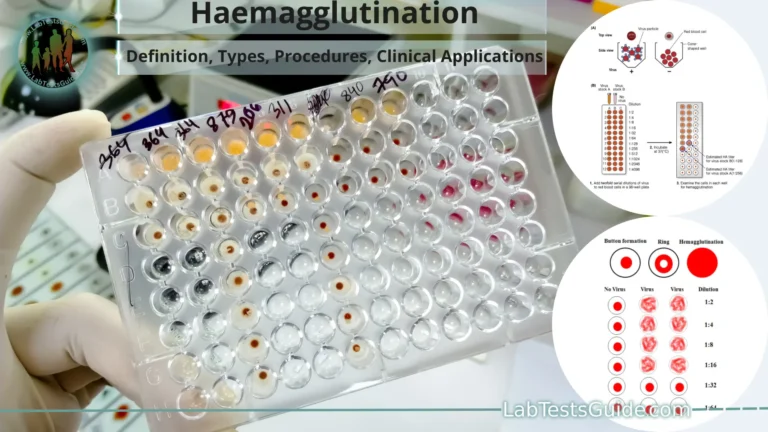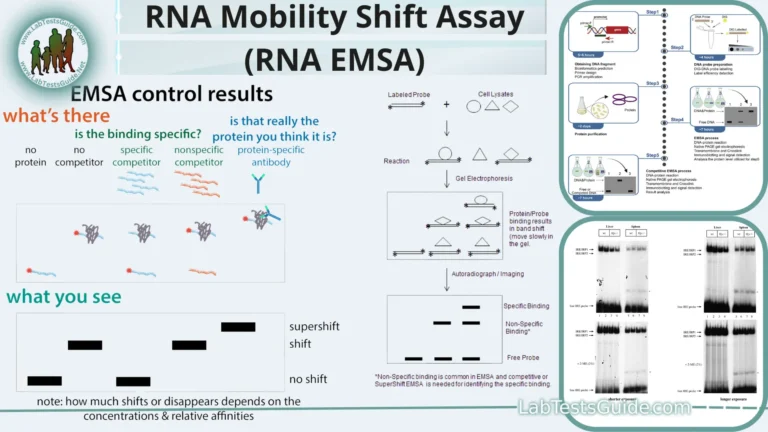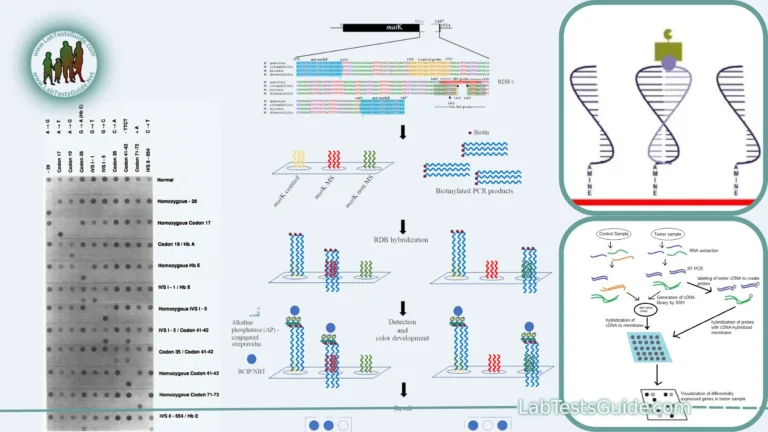An assay is a laboratory test or procedure used to analyze and measure the presence, quantity, or activity of a specific substance or biological component in a sample. Assays are widely used in various scientific disciplines, including chemistry, biology, medicine, and environmental science, to obtain quantitative or qualitative data about a particular substance or biological parameter.

- Definition: An assay is a laboratory technique used to measure, analyze, or detect the presence, quantity, or activity of a substance within a sample.
- Types: Assays come in various forms, including biochemical, immunoassays, cell-based, molecular, chemical, microbiological, radiometric, and more.
- Applications: Assays are employed in diverse fields such as biology, chemistry, medicine, pharmacology, and environmental science.
- Biochemical Assays: These assays analyze biological molecules like proteins, enzymes, and metabolites, often to determine their concentration or activity.
- Immunoassays: Immunoassays use antibodies to detect and measure specific molecules, widely used in medical diagnostics.
- Cell-Based Assays: These assays employ cultured cells to study cellular responses to stimuli or compounds, crucial in drug development.
- Molecular Assays: Focused on nucleic acids, these assays are essential for DNA/RNA analysis, including PCR and sequencing.
- Chemical Assays: They rely on chemical reactions to determine the presence or concentration of particular compounds.
- Microbiological Assays: Used to assess microbial activity, often seen in microbiology and food testing.
- Radiometric Assays: These assays use radioactive isotopes to measure parameters like uptake or decay.
- ELISA: A well-known immunoassay, Enzyme-Linked Immunosorbent Assay, is vital in medical diagnostics.
- High-Throughput Screening (HTS): HTS is used in drug discovery and genomics to test large numbers of compounds or genes efficiently.
- Biological Assays: They evaluate the biological activity of a substance, particularly important in pharmaceuticals.
- Potency Testing: Assays are used to determine the strength or efficacy of drugs or biologics.
- Quality Control: Assays play a critical role in ensuring the quality and safety of pharmaceuticals, food, and other products.
- Research Tools: Scientists use assays to explore cellular and molecular processes, aiding in the advancement of scientific knowledge.
- Diagnostic Tools: Assays are fundamental in diagnosing various diseases, including HIV, cancer, and pregnancy.
- Customization: Assays can be adapted and customized for specific research or diagnostic needs, making them versatile tools in the laboratory.
Definition of Assay.
An assay is a laboratory procedure or test that is performed to determine the presence, concentration, quality, or biological activity of a specific substance or component within a sample. Assays are used in various scientific and analytical disciplines to gather quantitative or qualitative data about a particular analyte, such as a chemical compound, biomolecule, microorganism, or biological activity.
What is importance in Scientific research?
Their importance in scientific research is multifaceted and can be summarized as follows.
Discovery and Characterization: Assays are essential for the discovery and characterization of new substances, compounds, biomolecules, or biological processes. Researchers use assays to identify and quantify these entities, providing the foundation for further investigation.
Hypothesis Testing: In the scientific method, researchers formulate hypotheses and then conduct experiments to test them. Assays are often the experimental tools used to gather data and test these hypotheses, allowing scientists to draw meaningful conclusions.
Data Generation: Assays generate quantitative or qualitative data that serve as the basis for scientific analysis and interpretation. These data are essential for making informed decisions and drawing valid conclusions in research.
Quality Control: Assays are used in quality control processes to ensure the consistency, purity, and quality of chemical compounds, drugs, food products, and other materials. They help maintain standards and safety in various industries.
Biomarker Identification: Assays are instrumental in identifying and validating biomarkers, which are indicators of biological processes or disease states. Biomarkers play a vital role in medical diagnosis, prognosis, and personalized medicine.
Disease Research: Assays are used to investigate the molecular and cellular mechanisms underlying diseases. This research contributes to a deeper understanding of diseases and can lead to the development of new treatments and therapies.
Advancing Knowledge: Assays enable researchers to explore and expand the boundaries of human knowledge. They contribute to the accumulation of scientific data and the development of theories and models.
Precision Medicine: Assays are integral to the field of precision medicine, where individualized treatment plans are tailored based on a patient’s unique genetic and molecular profile.
Types of Assays:
Here are some common types of assays,
Biochemical Assays:
- Enzyme Assays: Measure the activity or concentration of enzymes, often used in drug development and clinical diagnostics.
- Immunoassays: Detect and quantify specific proteins or antibodies using antigen-antibody interactions. Examples include ELISA and Western blotting.
Cellular Assays:
- Cell Viability Assays: Determine the viability and health of cells, crucial in drug testing and toxicity studies.
- Cell Proliferation Assays: Measure cell growth and division rates, essential in cancer research and drug development.
- Cell Signaling Assays: Evaluate cellular signaling pathways, helping understand how cells respond to stimuli.
Molecular Assays:
- Polymerase Chain Reaction (PCR): Amplify and detect specific DNA sequences, commonly used in genetics and diagnostics.
- DNA Sequencing: Determine the order of nucleotides in a DNA molecule, vital for genomics and genetic research.
- RNA Assays: Measure RNA expression levels and types, used in gene expression studies.
Chemical Assays:
- Titration: Determine the concentration of a chemical species in a solution by reacting it with a known reagent.
- Spectroscopic Assays: Analyze substances based on their interaction with light, including UV-Vis, IR, and NMR spectroscopy.
Microbiological Assays:
- Microbial Growth Assays: Measure the growth of microorganisms, often used in testing antimicrobial agents.
- Antibiotic Susceptibility Assays: Assess the sensitivity of bacteria to antibiotics.
Radiolabeling Assays:
- Radioimmunoassay (RIA): Use radioactive isotopes to label and detect specific molecules, commonly applied in hormone and drug testing.
- Autoradiography: Visualize the distribution of radioactive substances in a sample, often used in biology and medicine.
Imaging Assays:
- Fluorescence Microscopy: Use fluorescent probes to visualize and study cellular structures and processes.
- Electron Microscopy: Achieve high-resolution imaging of subcellular structures and nanoparticles.
Immunological Assays:
- Flow Cytometry: Analyze and sort cells or particles based on their fluorescence and light scattering properties.
- Immunohistochemistry (IHC): Visualize specific antigens in tissue sections, aiding in pathology and disease research.
Biological Assays:
- Bioassays: Assess the biological activity or potency of a substance, frequently used in pharmaceutical and biotechnology industries.
- Cell-Based Assays: Utilize live cells to measure the response to a substance, aiding in drug screening and toxicity testing.
Clinical Diagnostics:
- Diagnostic Assays: Detect and quantify disease markers, including blood tests, urine tests, and molecular diagnostic assays.
Assay Techniques and Methods:
Here are some common assay techniques and methods.
Chromatography:
- High-Performance Liquid Chromatography (HPLC): Separates and quantifies components in a mixture based on their interaction with a liquid mobile phase and a solid stationary phase.
- Gas Chromatography (GC): Separates and analyzes volatile compounds by their interaction with a gaseous mobile phase.
Mass Spectrometry (MS):
- Liquid Chromatography-Mass Spectrometry (LC-MS): Combines liquid chromatography with mass spectrometry for identifying and quantifying compounds in complex mixtures.
Electrophoresis: - Polyacrylamide Gel Electrophoresis (PAGE): Separates proteins or nucleic acids based on size and charge.
Capillary Electrophoresis (CE): Performs high-resolution separations of ions, small molecules, and biomolecules.
Titration:
- Acid-Base Titration: Determines the concentration of an acid or base in a solution by neutralization with a standard solution of known concentration.
- Redox Titration: Measures the concentration of a reducing or oxidizing agent in a sample by a redox reaction with a titrant.
Immunoassays:
- Enzyme-Linked Immunosorbent Assay (ELISA): Detects and quantifies specific antigens or antibodies using enzyme-labeled antibodies.
- Radioimmunoassay (RIA): Measures antigens or antibodies by using radioactive isotopes.
Molecular Biology Techniques:
- Polymerase Chain Reaction (PCR): Amplifies DNA sequences for detection and analysis.
- Western Blotting: Detects specific proteins in a sample using antibodies.
- Northern Blotting: Analyzes RNA molecules in a sample.
Flow Cytometry:
- Fluorescence-Activated Cell Sorting (FACS): Separates and analyzes cells based on their fluorescent properties, often used in immunology and cell biology.
Microscopy:
Fluorescence Microscopy: Visualizes fluorescently labeled molecules or cells.
Confocal Microscopy: Produces high-resolution 3D images of specimens using laser illumination.
Nuclear Magnetic Resonance (NMR) Spectroscopy: Analyzes the nuclear properties of atoms in a magnetic field, providing information about the structure and composition of compounds.
Enzyme Assays:
- Colorimetric Assays: Detect enzyme activity by measuring changes in color.
- Fluorometric Assays: Measure enzyme activity based on fluorescence changes.
Bioinformatics:
- Sequence Analysis: Analyzes DNA, RNA, and protein sequences to identify patterns and functions.
- Structural Bioinformatics: Predicts the structure and function of biomolecules.
Cell-Based Assays:
- High-Content Screening (HCS): Automates the imaging and analysis of multiple cellular parameters.
Electrochemical Techniques:
- Potentiostat/Galvanostat: Measures current or potential in electrochemical reactions.
Electrochemical Impedance Spectroscopy (EIS): Analyzes the impedance of electrochemical systems.
Microfluidics: Uses microscale fluid channels to perform assays, manipulate samples, and conduct experiments with small volumes. - Next-Generation Sequencing (NGS): Sequences DNA and RNA at high throughput, enabling genome-wide studies.
- Surface Plasmon Resonance (SPR): Measures changes in refractive index at the surface of a sensor chip to study molecular interactions.
Applications of Assays:
Here are some common applications of assays.
Medical Diagnostics:
- Clinical Chemistry Assays: Used to diagnose and monitor various medical conditions by measuring biomarkers in blood, urine, or other body fluids.
- Immunoassays: Detect antibodies, antigens, and hormones for diagnosing diseases like HIV, COVID-19, and cancer.
- Molecular Diagnostics: Detect genetic mutations, pathogens, and nucleic acids for personalized medicine and disease identification.
Pharmaceutical Research and Development:
- High-Throughput Screening (HTS): Identifies potential drug candidates by testing compounds against specific biological targets.
- Toxicology Assays: Assess the safety and potential toxicity of drugs and chemicals.
- Bioavailability Assays: Measure drug absorption and availability in the body.
Environmental Monitoring:
- Water Quality Testing: Assays are used to detect pollutants, pathogens, and chemical contaminants in water sources.
- Air Quality Monitoring: Analyze air samples for pollutants, particulate matter, and toxins.
Food and Beverage Industry:
Food Safety Testing: Detects contaminants like pathogens, allergens, and chemical residues in food products.
Quality Control Assays: Ensure product consistency and quality, such as measuring sugar content in beverages.
Biotechnology and Bioprocessing:
- Bioprocess Monitoring: Assays are employed to optimize and control the production of biopharmaceuticals and biofuels.
- Cell Line Development: Used to select and characterize high-producing cell lines in biomanufacturing.
Cancer Research:
- Biomarker Analysis: Identifies and quantifies specific proteins, genes, or molecules associated with cancer.
- Drug Sensitivity Testing: Assesses the response of cancer cells to various treatments.
Microbiology:
Microbial Identification: Determines the presence and identity of microorganisms, essential in clinical labs and environmental microbiology.
Antibiotic Susceptibility Testing: Measures the sensitivity of bacteria to antibiotics.:
Recent Advancements in Assay Technology:
Here are some recent advancements in assay technology:
- High-Throughput Screening (HTS) Automation: Automation systems and robotics have significantly increased the speed and efficiency of HTS assays, allowing the rapid screening of thousands to millions of compounds for drug discovery.
- Microfluidic Assays: Microfluidics enables the manipulation of tiny volumes of fluids, making it possible to perform assays with minimal sample consumption. It’s used for point-of-care diagnostics, single-cell analysis, and more.
- Next-Generation Sequencing (NGS): NGS technologies have revolutionized genomics and molecular biology by enabling high-throughput, rapid, and cost-effective DNA and RNA sequencing.
- Single-Cell Assays: Advances in single-cell technologies, including single-cell RNA sequencing (scRNA-seq) and single-cell proteomics, allow researchers to study individual cells within a heterogeneous population.
- CRISPR-Based Assays: CRISPR technology has been adapted for various assays, including CRISPR-based diagnostics (CRISPR-Dx) and CRISPR-Cas9 screens for functional genomics studies.
- Multiplexed Assays: Multiplex assays simultaneously detect and quantify multiple analytes in a single sample, saving time and resources. They are used in immunology, proteomics, and genomics.
- Digital PCR (dPCR): Digital PCR offers absolute quantification of nucleic acids by partitioning samples into thousands of individual reactions, providing higher precision and sensitivity compared to traditional PCR.
- High-Resolution Imaging: Advances in microscopy and imaging techniques, such as super-resolution microscopy and live-cell imaging, enable researchers to visualize cellular and molecular processes with unprecedented detail.
- Mass Cytometry (CyTOF): Mass cytometry combines flow cytometry with mass spectrometry, allowing the simultaneous measurement of numerous protein markers in single cells.
- Artificial Intelligence (AI) and Machine Learning: AI and machine learning algorithms are increasingly applied to assay data analysis, enhancing pattern recognition and predictive modeling.
- Organ-on-a-Chip: Microfluidic devices that mimic the functions of human organs offer new possibilities for drug testing, toxicity studies, and disease modeling.
- Single-Molecule Assays: Single-molecule techniques, such as single-molecule fluorescence and nanopore sequencing, provide insights into individual molecular events and interactions.
- Quantum Dots: Quantum dots are nanoscale semiconductor particles that emit specific wavelengths of light. They are used as fluorescent labels in assays for enhanced sensitivity and multiplexing.
- Portable and Point-of-Care Assays: Miniaturized and portable assay devices are being developed for use in resource-limited settings and for rapid on-site diagnostics.
- Biosensors: Biosensor technology, including electrochemical, optical, and microelectromechanical systems (MEMS) sensors, is advancing for real-time detection of biomolecules.
- CRISPR-Based Diagnostics: CRISPR-based diagnostic tests, such as SHERLOCK and DETECTR, offer rapid and highly specific detection of pathogens and genetic mutations.
- Long-Read Sequencing: Long-read sequencing technologies, like PacBio and Oxford Nanopore, provide more accurate and complete genomic information, particularly in repetitive regions.
FAQs:
What is an assay?
An assay is a laboratory procedure used to qualitatively or quantitatively measure the presence, amount, or functional activity of a target entity. The measured entity is often called the analyte, the measurand, or the target of the assay. Assays are used in a wide variety of fields, including medicine, mining, pharmacology, environmental biology, and molecular biology.
What are the different types of assays?
There are many different types of assays, and the specific type used depends on the analyte being measured and the desired outcome.
How accurate are assays?
The accuracy of an assay depends on a number of factors, including the type of assay, the analyte being measured, and the skill of the technician performing the assay. However, most assays are very accurate and reliable.
How are assay results interpreted?
Assay results are interpreted by comparing them to a reference range. The reference range is a set of values that is considered to be normal for the population. If the assay result falls outside of the reference range, it may indicate that there is a problem.
Who should I contact if I have questions about an assay?
If you have any questions about an assay, you should contact the healthcare professional who ordered the test. They will be able to explain the results of the test and answer any questions you have.
What is the difference between a qualitative assay and a quantitative assay?
A qualitative assay determines the presence or absence of an analyte, while a quantitative assay determines the amount of an analyte. For example, a pregnancy test is a qualitative assay that detects the presence of the hormone hCG in urine. A blood glucose test is a quantitative assay that measures the amount of glucose in the blood.
Conclusion:
Assays are essential tools for research and development in a wide range of fields. They are also used in routine clinical practice to diagnose and monitor diseases, and to ensure the safety and efficacy of drugs and other products.
Possible References Used






